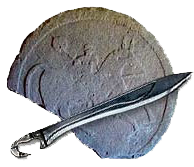Autor: Dingo
lunes, 18 de diciembre de 2006
Sección: Sobre los nombres
Información publicada por: Dingo
Mostrado 46.289 veces.
ADN mitocondrial de los iberos prerromanos
El estudio tiene algo más de una año, pero me parece de interés para celtiberia.net porque no se publican todos los días estudios sobre genética de poblaciones prerromanas de la península ibérica. En primer lugar copio el resumen, en inglés, del estudio. A continuación un fragmento que indica la composición en porcentajes de haplogrupos. Y al final comento en español los resultados más destacables del estudio. El texto completo se puede obtener subscribiéndose aquí:
http://www.blackwell-synergy.com/doi/abs/10.1111/j.1529-8817.2005.00194.x?journalCode=ahg
El estudio tiene algo más de una año, pero me parece de interés para celtiberia.net porque no se publican todos los días estudios sobre genética de poblaciones prerromanas de la península ibérica. En primer lugar copio el resumen, en inglés, del estudio. A continuación un fragmento que indica la composición en porcentajes de haplogrupos. Y al final comento en español los resultados más destacables del estudio. El texto completo se puede obtener subscribiéndose aquí:
http://www.blackwell-synergy.com/doi/abs/10.1111/j.1529-8817
--
Annals of Human Genetics
Volume 69 Issue 5 Page 535 - September 2005
The Genetics of the Pre-Roman Iberian Peninsula: A mtDNA Study of Ancient Iberians
M. L. Sampietro, D. Caramelli, O. Lao, F. Calafell, D. Comas, M. Lari, B. Agustí, J. Bertranpetit and C. Lalueza-Fox.
Summary
The Iberians developed a surprisingly sophisticated culture in the Mediterranean coast of the Iberian Peninsula from the 6th century BC until their conquest by the Romans in the 2nd century BC. They spoke and wrote a non-Indo-European language that still cannot be understood; their origins and relationships with other non-Indo-European peoples, like the Etruscans, are unclear, since their funerary practices were based on the cremation of bodies, and therefore anthropology has been unable to approach the study of this people. We have retrieved mitochondrial DNA (mtDNA) from a few of the scarce skeletal remains that have been preserved, some of them belonging to ritualistically executed individuals. The most stringent authentication criteria proposed for ancient DNA, such as independent replication, amino-acid analysis, quantitation of template molecules, multiple extractions and cloning of PCR products, have been followed to obtain reliable sequences from the mtDNA hypervariable region 1 (HVR1), as well as some haplogroup diagnostic SNPs. Phylogeographic analyses show that the haplogroup composition of the ancient Iberians was very similar to that found in modern Iberian Peninsula populations, suggesting a long-term genetic continuity since pre-Roman times. Nonetheless, there is less genetic diversity in the ancient Iberians than is found among modern populations, a fact that could reflect the small population size at the origin of the population sampled, and the heterogenic tribal structure of the Iberian society. Moreover, the Iberians were not especially closely related to the Etruscans, which points to considerable genetic heterogeneity in Pre-Roman Western Europe.
http://www.blackwell-synergy.com/doi/abs/10.1111/j.1529-8817.2005.00194.x?journalCode=ahg
--
The most frequent haplogroup is H (52.9%), followed by U (17.6%), J (11.8%), and pre-HV, K and T at the same frequency (5.9%). No samples were found to correspond to other haplogroups that are widely present in the Iberian peninsula populations (Table 7), such as V, X, I or W. The North African U6 subhaplogroup and Sub-Saharan African L lineages are also absent from the ancient Iberians analyzed so far; therefore, the possible entry of U6 lineages prior to the Muslim conquest in the 8th century A.D., as suggested by some authors, remains unproven. However, it is recognized that the sample size is at present too small to exclude any competing hypothesis about a possible North African genetic contribution to the genesis of the Iberian peninsula populations.
http://dienekes.blogspot.com/2005/07/pre-roman-iberian-mtdna.html
--
Para el estudio, se extrajo ADN mitocondrial de restos esqueletales de individuos, algunos de ellos ejecutados ritualmente. Los haplogrupos más frecuentes son:
H (52.9%)
U (17.6%)
J (11.8%)
pre-HV (5.9%)
K (5.9%)
T (5.9%)
Se comprueba que la composición en haplogrupos de los antiguos iberos es muy similar a la de las poblaciones peninsulares actuales (si bien se encuentra una menor diversidad genética en los restos antiguos). Con todo, no se han encontrado haplogrupos actualmente ampliamente extendidos por la península ibérica como V, X, I o W.
Los haplogrupos africanos U6 (norteafricano) y L (subsahariano) también están ausentes entre los antiguos iberos, de lo cual se sigue que la llegada de U6 a la península anterior a la conquista musulmana del siglo VIII, como algunos autores sugirieron, sigue sin estar provada.
Con todo, el tamaño de la muestra utilizada es demasiado pequeño para excluir una posible contribución norteafricana en la génesis de los iberos.
Otra conclusión a destacar es que los iberos no estaban especialmente relacionados con los etruscos.
-
No hay imágenes relacionadas.
Comentarios
 Pulsa este icono si opinas que la información está fuera de lugar, no tiene rigor o es de nulo interés.
Pulsa este icono si opinas que la información está fuera de lugar, no tiene rigor o es de nulo interés.
Tu único clic no la borarrá, pero contribuirá a que la sabiduría del grupo pueda funcionar correctamente.
Si te registras como usuario, podrás añadir comentarios a este artículo.

Más genes pirenaicos, los andorranos (basados en una muestra de hacia 3300 AC):
Haplogroupes
Pays Basque - Catalogne - Andorre
X 1.2 2.2 0.0
V 10.8 3.3 3.5
K 4.4 5.6 16.6
H 58.9 44.4 51.8
U 14.1 11.1 22.4
T 5.1 13.3 9.4
W - 0.0 0.0
J 2.5 13.3 4.7
I - 0.0 7.1
Autre 2.5 - -
Source: Bertranpetit et al., 1995 et Corte-Real et al., 1996 ; * Montiel, 2001 ; * Anglés et al., 2003.
extraído de "Determination genétique de l’individu Néolithique de Segudet (Ordino), les restes
humains les plus anciens d’Andorre" en PDF... usar el google)
Hay 1 comentarios.
1